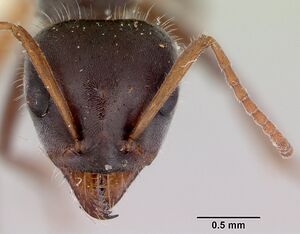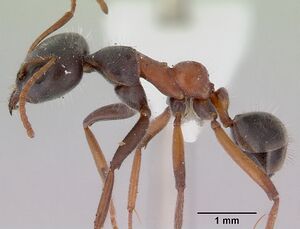Iridomyrmex anteroinclinus
| Iridomyrmex anteroinclinus | |
|---|---|

| |
| Scientific classification | |
| Kingdom: | Animalia |
| Phylum: | Arthropoda |
| Class: | Insecta |
| Order: | Hymenoptera |
| Family: | Formicidae |
| Subfamily: | Dolichoderinae |
| Tribe: | Leptomyrmecini |
| Genus: | Iridomyrmex |
| Species: | I. anteroinclinus |
| Binomial name | |
| Iridomyrmex anteroinclinus Shattuck, 1993 | |
Identification
Iridomyrmex anteroinclinus shares with close relatives a markedly flattened petiolar node with a much reduced anterior face, as well as the short, concave frontal carinae. However, it differs in the infuscation of both the head capsule and the pronotum. Nothing is known about the biology of the species (see Shattuck, 1993b).
Keys including this Species
Distribution
Latitudinal Distribution Pattern
Latitudinal Range: -14.11666667° to -25.958045°.
| North Temperate |
North Subtropical |
Tropical | South Subtropical |
South Temperate |
- Source: AntMaps
Distribution based on Regional Taxon Lists
Australasian Region: Australia (type locality).
Distribution based on AntMaps
Distribution based on AntWeb specimens
Check data from AntWeb
Countries Occupied
| Number of countries occupied by this species based on AntWiki Regional Taxon Lists. In general, fewer countries occupied indicates a narrower range, while more countries indicates a more widespread species. |

|
Estimated Abundance
| Relative abundance based on number of AntMaps records per species (this species within the purple bar). Fewer records (to the left) indicates a less abundant/encountered species while more records (to the right) indicates more abundant/encountered species. |

|
Biology
Castes
Worker
Images from AntWeb
   
| |
| Holotype of Iridomyrmex anteroinclinus. Worker. Specimen code casent0172045. Photographer April Nobile, uploaded by California Academy of Sciences. | Owned by ANIC, Canberra, Australia. |
Nomenclature
The following information is derived from Barry Bolton's Online Catalogue of the Ants of the World.
- anteroinclinus. Iridomyrmex anteroinclinus Shattuck, 1993b: 1311, figs. 28, 29, 37 (w.) AUSTRALIA. See also: Heterick & Shattuck, 2011: 45.
Type Material
- Holotype, worker, King Edward River, Kimberley Region, Western Australia, Australia, 15°08′50″S 126°08′40″E / 15.14722°S 126.14444°E, ANIC32-000009, Australian National Insect Collection.
- Paratype, 1 worker, Mining Camp, Mitchell Plateau, Western Australia, Australia, ANIC32-000007, Australian National Insect Collection.
- Paratype, 1 worker, Cape Bernier, Kimberley Region, Western Australia, Australia, ANIC32-000008, Australian National Insect Collection.
Description
Worker Description. Head. Posterior margin of head weakly concave; erect setae on posterior margin in full- face view set in a row; sides of head noticeably convex; erect genal setae present on sides of head in full-face view. Number of ocelli one (a minute ocellus), position of obsolete ocelli indicated by small pits only or pits lacking; in full-face view, eyes set at about midpoint of head capsule; in profile, eye set anteriad of head capsule; eye semi-circular. Frontal carinae concave; antennal scape surpassing posterior margin of head by 1–2 x its diameter. Erect setae on scape present and abundant; prominence on anteromedial clypeal margin present as an indistinct swelling or undulation; mandible elongate triangular with oblique basal margin; long, curved setae on venter of head capsule present. Mesosoma. Pronotum weakly undulant or almost straight. Erect pronotal setae numerous (12 or more) and longest setae elongate, flexuous and/or curved. Mesonotum straight. Erect mesonotal setae numerous (12 or more) and elongate, flexuous and/or curved. Mesothoracic spiracles always prominent as small, vertical protuberances; propodeal dorsum protuberant; placement of propodeal spiracle mesad, more than its diameter away from propodeal declivity; propodeal angle weakly present or absent, the confluence of the dorsal and declivitous propodeal faces indicated, if at all, by an undulation. Erect propodeal setae numerous (12 or more) and elongate, flexuous and/or curved. Petiole. Dorsum of node a thin rim only; node reduced to anterior lip only, the rest incorporated in the petiole. Gaster. Non-marginal erect setae of gaster present on first gastral tergite; marginal erect setae of gaster present on first tergite. General characters. Allometric differences between workers of same nest absent. Colour head, gaster, coxae, fore femora and tibiae brown, most of mandibles, part of clypeus, mid and hind legs (except coxa) and most of mesosoma bright orange, pronotum a cloudy brown-orange.
Measurements. Worker (n = 3)—CI 100–102; EI 24–27; EL 0.33–0.37; EW 0.20–0.23; HL 1.22–1.38; HW 1.22–1.38; ML 0.59–0.66; PpH 0.23–0.26; PpL 0.70–0.80; SI 8 1–84; SL 0.99–1.15.
References
- Heterick, B.E. & Shattuck, S.O. 2011. Revision of the ant genus Iridomyrmex (Hymenoptera: Formicidae). Zootaxa 2845: 1-175.
- Heterick, B.E. 2021. A guide to the ants of Western Australia. Part I: Systematics. Records of the Western Australian Museum, Supplement 86, 1-245 (doi:10.18195/issn.0313-122x.86.2021.001-245).
- Heterick, B.E. 2022. A guide to the ants of Western Australia. Part II: Distribution and biology. Records of the Western Australian Museum, supplement 86: 247-510 (doi:10.18195/issn.0313-122x.86.2022.247-510).
- Shattuck, S. O. 1993b. Revision of the Iridomyrmex calvus species-group (Hymenoptera: Formicidae). Invertebr. Taxon. 7 7: 1303-1325 (page 1311, figs. 28, 29, 37 worker described)
References based on Global Ant Biodiversity Informatics
- Heterick B. E., and S. Shattuck. 2011. Revision of the ant genus Iridomyrmex (Hymenoptera: Formicidae). Zootaxa 2845: 1-174.
- Shattuck S. O. 1994. Taxonomic catalog of the ant subfamilies Aneuretinae and Dolichoderinae (Hymenoptera: Formicidae). University of California Publications in Entomology 112: i-xix, 1-241.

